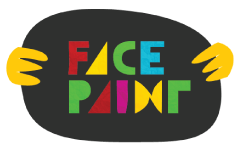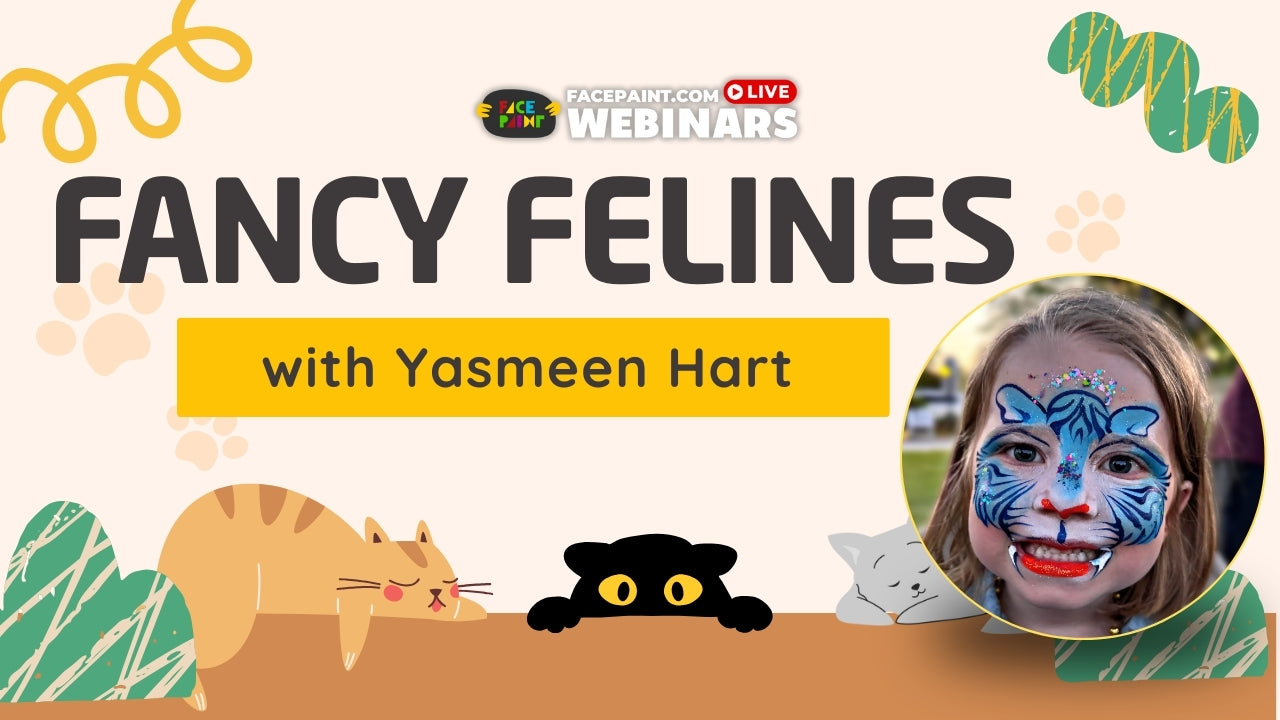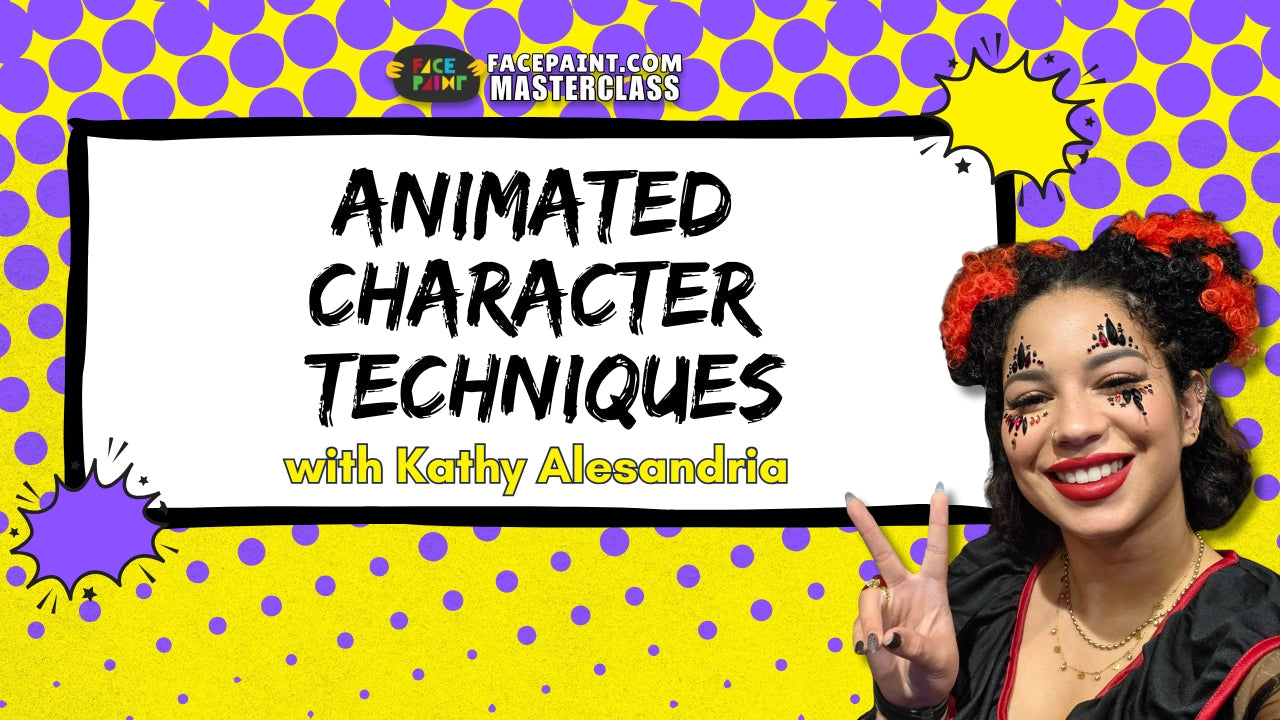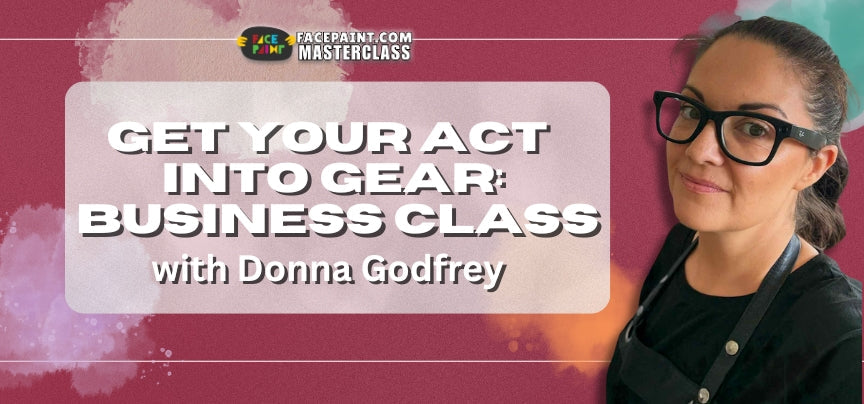Owner of FacePaint.com, Blake Cabot, was joined live on Zoom and Facebook, by talented special effects artist and winner of the Instagram Halloween Challenge, Cris Alex. For the Instagram Halloween Challenge, Cris Alex painted this very intricate exposed muscle design, which ultimately won her the grand prize!

Cris is a special FX artist from Los Angeles and she did this amazing design for us today, which is exposed muscle with blacklight bones in the background - be prepared to be amazed!
So I'm going to start out with the muscles, because the bones in the image are a translucent UV, so I did everything in different face paints and products. So I'm going to start with the pink from the Kraze FX Fundamentals Palette, and I'm just going to do a really quick base, and I'm using just a regular foundation brush. I use sponges as well, but sometimes it's just easier because brushes are right there and convenient!
Now I'm taking a skinnier brush and mapping out the muscles, using the same pink face paint. I'm just figuring out which muscles overlap and doing the striations to keep with that muscle texture. Right now, it doesn't really look like much, but the guide helps me to keep track of what goes on top of what. I'm also going to come in with a couple of different colors to give it more dimension.
I'll use the red from the Kraze FX palette to build onto the muscles, adding more striations. It's a sort of "trust the process" type of thing, because at first it doesn't look like much, but you just keep building onto it. It will look like something in the end! That's another reason why I did the pink base first, so I don't have to worry about exposed skin later on. I'm taking a red and black mixture, but adding a little more black this time.
I studied special effects painting, which is different than traditional face painting - it's all about layering. The more you layer, the more dimension you get. For some of the tendon area, where the muscle is going to be attached, I'm going to take some white and yellow and make a little mixture. So this is basically the tendon tissue that's holding that muscle onto the bone.
So a lot of the times too, especially with the water based paints, which need to be reactivated, so I do spray once in a while with the sealer. It's just a very light, thin coat sealer. Sometimes I'll incorporate alcohol based and I'll use that as a bottom layer.
I'm going to go in and flush some of the shadows a little bit more with the black. And sometimes for shading and stuff, I do use Starblend or kind of a powder, but I found that with doing the muscle, going straight in with black face paint worked great because I can still do those striations and get that depth in the muscle tissue. I'm going to bring a few of these striations in the middle of the muscle just to give it a little more interest. So it's not all just on one side.
I'm using pretty thin consistency for this, so I don't accidentally commit to something that's too dark. Once in a while, I'll come in with a little red, to give the design some separation and depth. I'm doing a soft outline using a little bit of the pink and the white. I want to save the pure white for the last little bright highlights. Just adding some pink now to some of the edges of the muscles, so it makes it pop.
Also, some of the highlights, they don't necessarily need to be straight lines. I'm also making sure that I'm bringing my highlights into other areas as well, so it doesn't just look too one-note. I'm going to add some white into those tendon areas because it disappeared a little bit. So now I'm going to go ahead and put down some of the white. I keep the white highlights to the high points of the muscle, and how the light would catch it. I'm going to now go in there and carve out some of the shadows with the black.
I'm going to add some deeper lines with the black now, just to make it look a little more interesting. So you can now see the overlapping of the shadows and highlights. And the nice thing is when you're doing it on the skin, the high points on the skin just pop up. So I'm going to go ahead and seal it again with the sealer so I don't disturb the muscle area.
So I turned on my blacklight, and I use Skin Illustrator Firefly Glo-Worm, and it's translucent, but it glows in blacklight. The trick though, because it is translucent, you do need to paint it under blacklight. You have to find a balance with some blacklight and a little bit of actual light, so you can see what you're doing. To start out, I just start painting in the bones with the translucent paint. So the thing that kind of sucks, is you can't mess up, you can't take it off, because you've got paint underneath. This part is definitely nerve wrecking, but it's a really cool effect.
So I did it a little thin, because admittedly I worry that I mess up. I'm going to go over it again, and hopefully it will read better on camera. In the original makeup, I put a little more dimension to make them look a little more 3D using an airbrush. Now I'm going to put a little dimension in there, so I have this cool little airbrush that's cordless which is super handy. I don't always like traveling with liquid airbrush, so a trick I use is just a big fat brush dipped in water or alcohol (depending on what paint I'm using), and then I dip it into the airbrush cup.
Now I'm just going to go ahead and airbrush some shadows onto the bones. As you can see, I'm just building a little dimension in there. It's also a nice way to build up the outline a little bit. There are a few places that need cleaning up, so I'm just going to go back with that brush.
I did a convention actually, where I did my normal makeup, and I just added this over top and did a skull, so you could only see it when I used the blacklight. It's a fun little Halloween trick!
Cris Alex Q&A

Q: Did you study anatomy?
A: I actually did, because in special effects school, we did have to do certain academic courses, so there was an anatomy course where we did bones, and we also ran through the muscle. But I do still use a reference for it, I don't rely on just my mind's eye to do any sort of anatomy stuff.
Q: What machine are you using?
A: This is actually one I go off of Amazon, called Gocheer, and it came with the gun and the compressor, but you can use your own gun on there, which is nice. I also have a full compressor and a bunch of airbrush guns, but I like the idea of having a cordless one, especially if you don't have access to a power plug, if you're out on location or something like that.
Q: Could you also use neon face paint instead of the Firefly Glo-Worm?
A: Yeah, you could, but the fun part about this, is that you can paint it on the skin, put the blacklight on and you'll see it. But, once you take the blacklight away, it's completely gone!
Q: What consistency is your white paint when you sweep it over?
A: I have it as a pretty dry mixture, so that it's a nice opacity. So yes, I tend to do it pretty dry. Towards the end, especially with the black, I am using a drier mixture so that's it's the opacity and depth that I want it to be.
Q: How many hours did it take you to make the design you made for the Instagram Halloween challenge?
A: That design took 7 hours, with a couple of breaks as well, because it's a long time to just sit and paint.
Q: What size brush are you using to make the tendons and striations?
A: I think it's about a 6, I want to say, but I'm not sure because it doesn't have the number on it. It's actually a filbert brush, which is more oval. This is actually the same brush I used to make almost the entire design!
Q: Who was the model for the design?
A: The model was my husband because he lives with me, so I can make sure he sits still.
Products Used in This Webinar:
Kraze FX Fundamentals Palette
Filbert Brush
Skin Illustrator Firefly Glo-Worm
Gocheer Cordless Airbrush
______
Thank you to Cris Alex and all who tuned in to this webinar! Be sure to check out our upcoming webinars!
 FREE SHIPPING FOR USA ORDERS OVER $100
FREE SHIPPING FOR USA ORDERS OVER $100








Leave a comment (all fields required)